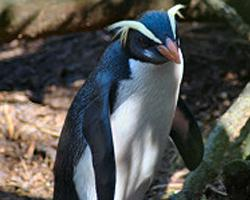
Váhy a míry
| Výška v kohoutku | 70 cm |
|---|---|
| Hmotnost | od 5 do 6 kg |
| Délka rozpětí křídel | 70 cm |
Stav ohrožení
| Ohrožen |
Popis zvířete
The Macaroni Penguin (Eudyptes chrysolophus) is a charismatic and easily recognizable species of penguin known for its distinctive crest of yellow and black feathers. As a member of the genus Eudyptes, the Macaroni Penguin is one of several crested penguins, and it boasts one of the most prominent and colorful crests among its relatives.Adult Macaroni Penguins typically stand about 70 centimeters (28 inches) tall and weigh around 3.5 to 6.4 kilograms (7.7 to 14.1 pounds), with males generally being larger and heavier than females. They have a robust, streamlined body that is perfectly adapted to an aquatic life, enabling them to be excellent swimmers. Their flippers are strong and flattened, which, along with their torpedo-shaped body, allows them to navigate through the water with grace and speed, reaching speeds of up to 35 kilometers per hour (22 miles per hour).
The plumage of the Macaroni Penguin is primarily black on the back and white on the belly, a counter-shading pattern that provides camouflage in the water; from below, their white belly blends with the sky's light, and from above, their dark back melds with the ocean depths. Their faces are also black, with a white patch above the eye extending to the top of the head. The most striking feature of the Macaroni Penguin is its vibrant yellow-orange crest, which originates just above the eyes and sweeps backwards. These flamboyant feathers stand out against the bird's black head, giving the penguin its unique and dapper appearance.
The beak of the Macaroni Penguin is long, sturdy, and sharply pointed, an adaptation for catching and holding onto slippery prey such as krill, squid, and small fish. Around the base of the beak, they have pinkish skin that adds to their colorful visage. Their eyes are red or reddish-brown, which stands in stark contrast to their dark feathering and adds to their striking appearance.
Macaroni Penguins are highly social animals, often found in large, densely packed colonies when breeding. These colonies can be incredibly noisy, with individuals communicating through a series of loud braying calls, which can be heard over considerable distances. During the breeding season, these penguins engage in elaborate courtship displays that include head and flipper waving, bowing, and mutual preening to strengthen pair bonds.
They breed on sub-Antarctic islands and the Antarctic Peninsula, preferring steep, rocky terrain where they can build their nests out of stones, grass, and feathers. The breeding cycle is a demanding time, with both parents sharing responsibilities of incubating the eggs and feeding the chicks. Chicks are born with a downy coat, which they later molt to reveal their waterproof juvenile plumage.
Outside the breeding season, Macaroni Penguins spend most of their time at sea, foraging and covering vast distances in the Southern Ocean. Their life at sea is not without danger, as they face threats from various predators, including leopard seals, fur seals, and orcas.
Despite their hardiness and adaptability, Macaroni Penguins are considered vulnerable to a number of threats, including climate change, which affects their food supply, and human activities such as overfishing and pollution. Conservation efforts are ongoing to ensure the survival of these unique and fascinating creatures, which play an integral role in the marine ecosystems of the Southern Hemisphere.
Mapa výskytu

Podobná zvířata
Nové fotografie zvířat
Top 10 zvířat
- Dolphin gull (Leucophaeus scoresbii)
- Diana monkey (Cercopithecus diana)
- Moustached guenon (Cercopithecus cephus)
- Galápagos tortoise (Geochelone nigra complex)
- Stone loach (Barbatula barbatula)
- Japanese macaque (Macaca fuscata)
- Greek tortoise (Testudo graeca)
- Russian tortoise (Testudo horsfieldii)
- Common flying dragon (Draco volans)
- Galápagos penguin (Spheniscus mendiculus)


